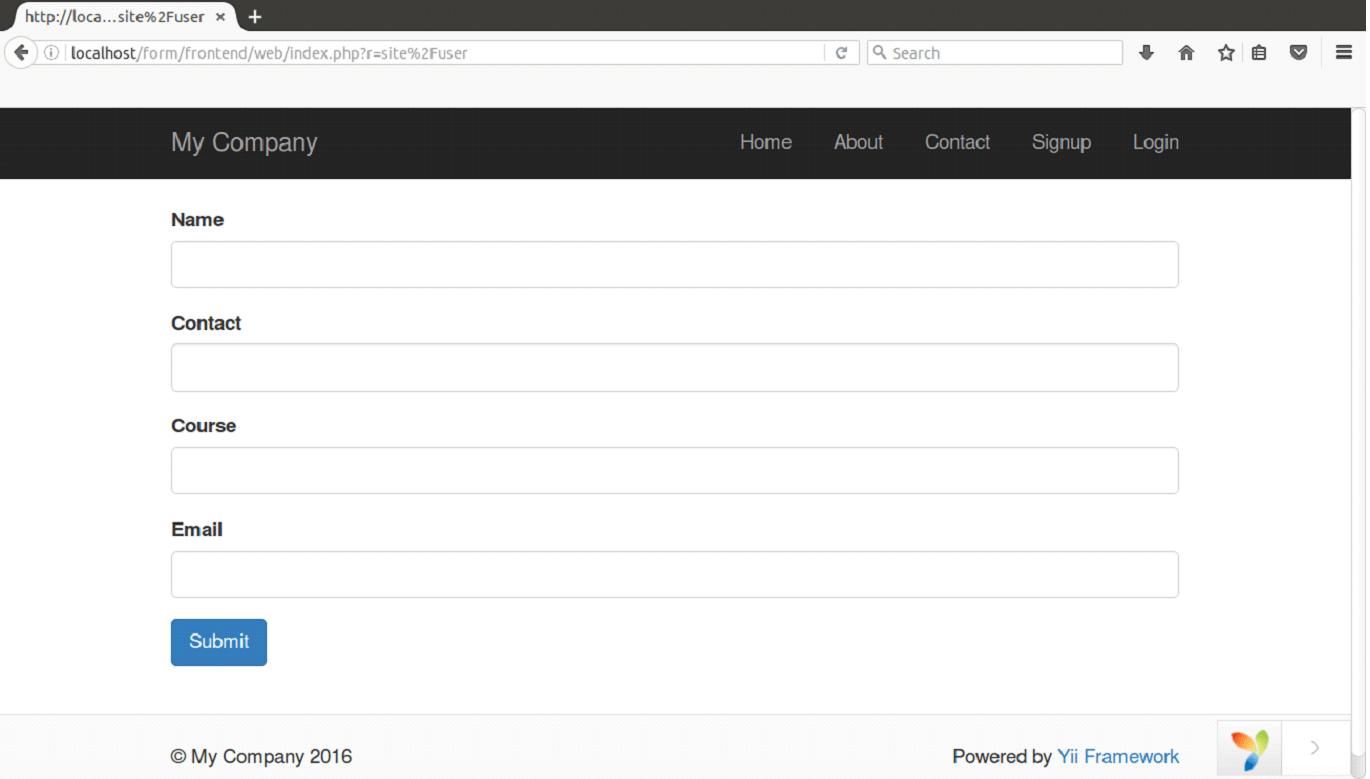Url::base($scheme = false)
base函数返回当前请求的基地址,它有一个参数$scheme,默认为false,代表返回地址不包含主机信息。
$scheme参数说明
- false 返回地址不包含主机信息
- true 包含主机地址
- http 返回http协议的主机地址
- https 返回https协议的主机地址
- ” 返回相对的主机地址
我们以http://yii2-study.local.com/i… 来举例
Url::base();
// 返回为''
Url::base(true)
// 返回为http://yii2-study.local.com
// 记住:最后没有反斜杠哦
Url::base('http');
// 返回为http://yii2-study.local.com
Url::base('https');
// 返回为https://yii2-study.local.com
Url::base('');
// 返回为//yii2-study.local.com切记:http https ”这些参数,函数base并没有去判断,只是简单的字符串替换,如果你输入了base(‘d’),则返回
d://yii2-study.local.com
Url::canonical()
返回当前请求的标准url
我们还是以http://yii2-study.local.com/i… 来举例
echo Url::canonical();
// 返回结果为 http://yii2-study.local.com/index.php?r=site/indexUrl::current(array $params = [], $scheme = false)
返回当前请求+GET参数,重点是该函数配合参数还能增加删除GET参数,这在我们某些url匹配时候会变得非常有用。
我们以http://yii2-study.local.com/i… 来举例
echo Url::current();执行上述代码后我们会得到 /index.php?r=site/index&id=78&cat=me 这样的结果
请注意,current()和canonical()区别,如果对本例里的url执行canonical()函数,会得到http://yii2-study.local.com/i… ,相比较current,它多了主机信息,少了GET参数(路由请求除外)。
上面是current获取当前的Url,我们还可以使用current对请求进行修改和删除等操作。
例子1:我们对当前请求增加一个name=abei GET参数,只需要执行
echo Url::current(['name'=>'abei']);于是我们获得了预想的结果/index.php?r=site/index&id=78&cat=me&name=abei
例子2:我们要删除例子url中的cat参数,只需要执行
echo Url::current(['cat'=>null]);则结果为/index.php?r=site/index&id=78 哈哈,cat参数被删除了
千万记住:删除一个GET参数的时候,只能设置current对应参数值为null,设置成false或”都是没用的。
例子3:更新例子中url的cat参数为you
echo Url::current(['cat'=>'you']);是的,yii2很贴心的将将结果返回为 /index.php?r=site/index&id=78&cat=you。感谢薛强,虽然现在在yii2的github已经看不到你的comment,仍然要感谢你创造了yii2.
一个大问题,current返回的结果中如何包含主机信息那?
你只需,只需将current的第二个参数设置为true就ok了。
Url::to($url = ”, $scheme = false) 和 Url::toRoute($route, $scheme = false)
生成一个URL,to()和toRoute()只有一个不同,那就是当to()的第一个函数为一个字符串的时候,会直接返回,而toRoute会将其解析成controller/action或action,然后返回url。
下面我们来举几个例子来说明下
Url::to(['site/about','cat'=>'abei']);
Url::toRoute(['site/about','cat'=>'abei']);
// 以上两个函数输出了同一个结果 index.php?r=site/about&cat=abei
Url::to('site/index');
Url::toRoute('site/index');
// 以上两个函数输出结果不同 to()的结果为site/index toRoute()的结果为index.php?r=site/index
Url::to();
Url::toRoute();
// to()无参数时返回了当前的路由+GET,而toRoute报错了(toRoute第一个参数不允许不存在)
Url::to("@web/images/logo.gif");
Url::toRoute("@web/images/logo.gif");
// to和toRoute均支持别名。
Url::to(['site/index','#'=>'name');
Url::toRoute(['site/index','#'=>'name')
// 这里有一个特殊的#,使用他能实现内部锚点,to和toRoute均可以生成index.php?r=site/index#name当然,to和toRoute也有第二个参数,决定返回的url是否含有主机信息。
哥俩好~ Url::previous($name = null)和Url::remember($url = ”, $name = null)
你是否有过这样的需求,比如记录一个会员最近30个访问的路径,使用previous和remember就能轻易实现,就和他们的名字一样,用remember可以存储当前路径,使用previous可以把remember存起来的url展示出来。
来来来,贴代码,其他都没有用。
Url::remember('http://www.a.com','a');
Url::remember('http://www.b.com','b');
var_dump(Url::previous('a'));
// 结果输出了http://www.a.comyii2记住了,小提示,是session原理。
我想细心的你一定发现了,是的,previous和remember的参数是可以为空的,没错,阿北用代码来说明。
我们还是以 http://yii2-study.local.com/i…为例
echo Url::previous();
// 当previous参数为空时,返回returnUrl。
echo Url::remember();
// 对于remember函数,当第一个参数$url不提供,将记住当前路由请求(即http://yii2-study.local.com/index.php?r=site/index),第二个参数$name不提供,则默认为yii\web\User::$returnUrlParam其他!
当然Url还有一些其他函数,比如home()等,比较简单,就不一一说明,主要上面几个大方法掌握了,Url基本就过了。







